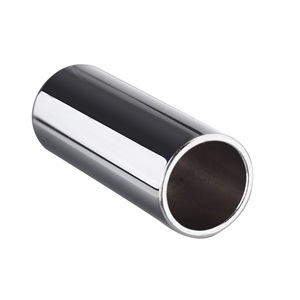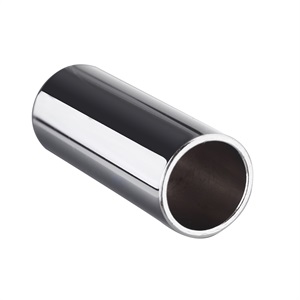What can the Chrome plated Stainless Steel Pipe do? If you are looking for this answer, you are in the right place.
What is chrome
(Wow! The content is a bit boring, but it is professional.)

Chromium is the most important alloying element in austenitic stainless steel. The rust and corrosion resistance of austenitic stainless steel is mainly due to the fact that chromium promotes the passivation of steel and keeps the steel stable and passive under the action of mass. the result of.
The effect of chromium on the tissue:
In austenitic stainless steels, chromium is an element that strongly forms and stabilizes the iron body, shrinking the austenite region, and as the content in the steel increases, ferrite (δ) structure can occur in the austenitic stainless steel.
Studies have shown that in chromium-nickel austenitic stainless steel, when the carbon content is 0.1% and the chromium content is 18%, in order to obtain a stable single austenite structure, the required nickel content is the lowest, about 8%. In general, the commonly used 18Cr-8Ni type chrome-nickel austenitic stainless steel is the most suitable one with chromium content and nickel ratio.
In austenitic stainless steels, as the chromium content increases, the formation of some intermetallic phases (such as δ phase) tends to increase. When the steel contains molybdenum, the chromium content will increase and the formation will be equal, as before. The precipitation of σ and χ phase not only significantly reduces the ductility and toughness of the steel, but also reduces the corrosion resistance of the steel under some conditions. The increase of the chromium content in the austenitic stainless steel can change the martensite to hydrocarbon temperature (Ms). ) decreases, thereby increasing the stability of the austenite matrix.
Therefore, high chromium (such as more than 20%) austenitic stainless steel is difficult to obtain martensite structure even after cold working and low temperature treatment.
Chromium is a strong carbide forming element, and it is no exception in austenitic stainless steel. The common chromium carbide in austenitic stainless steel is Cr23C6; when the steel contains molybdenum or chromium, it can also be found in the expired Cr6C and other carbides. The formation of the steel will have a significant impact on the properties of the steel under certain conditions.
The effect of chromium on performance:
Generally speaking, as long as the austenitic stainless steel maintains a complete austenite structure without the formation of δ ferrite, etc., only increasing the chromium content in the steel does not have a significant effect on the mechanical properties, and chromium has the greatest influence on the properties of the austenitic stainless steel. Is corrosion resistant,
The main performance is: chromium improves the performance of steel oxidation resistant medium and acid chloride medium; under the combined action of nickel and molybdenum and copper, chromium improves the performance of steel against some reducing medium, organic acid, urea and alkali medium;
Chromium also increases the resistance of steel to localized corrosion, such as intergranular corrosion. The most influential factor on the sensitivity of intergranular corrosion of austenitic stainless steels is the carbon content in steel. The effect of other elements on intergranular corrosion depends mainly on the effect of carbide dissolution and precipitation behavior.
The effect of chromium on the stress corrosion resistance of austenitic stainless steel varies with the experimental medium conditions and the actual use environment. In the MgCl2 boiling solution, the effect of chromium is generally harmful, but in the aqueous medium containing Cl- and oxygen, Under the condition of stress corrosion of high temperature and high pressure water and pitting corrosion, increasing the chromium content in steel is beneficial to stress corrosion resistance.
At the same time, chromium can also prevent the tendency of intergranular stress corrosion in austenitic stainless steels and alloys due to the increase of nickel content. For cracking (NaOH) stress corrosion, the effect of chromium is also beneficial. The corrosion resistance of the stainless steel has an important influence, and it can also significantly improve the oxidation resistance, corrosion resistance and corrosion resistance of the steel.
Reasons For Chrome plated Stainless Steel Pipe

Above we have analyzed what is chromium from a professional point of view, then we return to the original topic, what is the reason for stainless steel chrome?
The rust resistance is improved
Martensitic stainless steel in stainless steel, such as 2Cr13, 3Cr13, 9Cr18, 9Cr18MoV, Cr17Ni2, etc., containing more than 12% by weight of chromium, but stainless steel containing no nickel or a small amount of nickel, will change color and corrode in the atmosphere. In order to improve corrosion resistance, it can be plated with decorative chrome or hard chrome.
Improve the appearance
The stainless steel products are combined with the chrome-plated decorative chrome, and the appearance is obviously different. In order to make the appearance and color uniform, the stainless steel is often chrome-plated.
Improve the hardness of stainless steel
In particular, austenitic stainless steel has a low hardness, although it has good corrosion resistance, but it is not wear-resistant. Therefore, hard chrome plating is required to increase hardness, increase wear resistance, and prolong service life.
Milky white chrome layer
In order to obtain a soft coating that is not dazzling, such as stainless steel measuring tools (pieces, micrometers, etc.) scales or plates can be plated with white hard chrome, which is both decorative and optical.
